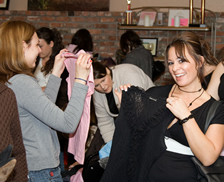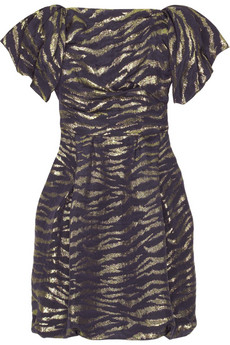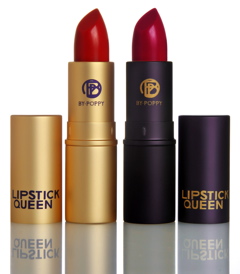The New Black… Friday
 Thanks to the crumbling economy and my dwindling bank account, I’ve restricted my clothing intake to mere window-shopping (oh what fun!). During one of my recent browsing-only excursions at Saks Fifth Avenue, I was dumbfounded upon discovering dozens of “Pre-Sale” racks filled with unsold discounted designer duds on the sales floor, something unheard of at the beginning of November! Sales of this magnitude typically don’t start until after Thanksgiving (a.k.a. Black Friday). This prompts the question: how are retailers responding to such quick and major shifts in consumer buyer behavior in times of such economic uncertainty and volatility?
Thanks to the crumbling economy and my dwindling bank account, I’ve restricted my clothing intake to mere window-shopping (oh what fun!). During one of my recent browsing-only excursions at Saks Fifth Avenue, I was dumbfounded upon discovering dozens of “Pre-Sale” racks filled with unsold discounted designer duds on the sales floor, something unheard of at the beginning of November! Sales of this magnitude typically don’t start until after Thanksgiving (a.k.a. Black Friday). This prompts the question: how are retailers responding to such quick and major shifts in consumer buyer behavior in times of such economic uncertainty and volatility?
Lucky for you, I recently attended the Fashion Group International’s seasonal Prêt-a-Porter event in New York, where I witnessed a panel of leading fashion influencers (Barneys’ Simon Doonan to Vogue’s Sally Singer) banter about a host of these related topics. I don’t know about you, but as an avid shopper, I’m dying to know what tricks retailers have up their sleeves for luring customers in during what’s arguably the most dismal holiday season since the Great Depression. So before you plan your next shopping jaunt, do yourself a favor and arm yourself with these newfangled retail strategies. Read more after the Jump!
 Shopping Will Be More Fun. To boost business, retailers such as Barneys New York are looking for non-traditional ways to further engage the customer. Rather than pressure people to buy, they’re focusing on interactive in-store events that encourage shoppers to let loose and have fun. So in celebration of Woodstock’s upcoming 40th anniversary, Barneys is pushing their “Have A Hippie Holiday” ad campaign. Picture decked out window displays filled with boho-inspired fashions, psychedelic peace signs and corresponding sidewalk events that are expected to lure you into the shop. Peace out!
Shopping Will Be More Fun. To boost business, retailers such as Barneys New York are looking for non-traditional ways to further engage the customer. Rather than pressure people to buy, they’re focusing on interactive in-store events that encourage shoppers to let loose and have fun. So in celebration of Woodstock’s upcoming 40th anniversary, Barneys is pushing their “Have A Hippie Holiday” ad campaign. Picture decked out window displays filled with boho-inspired fashions, psychedelic peace signs and corresponding sidewalk events that are expected to lure you into the shop. Peace out!
Less Equals More. Clothing collections are being scaled back and carefully edited to prevent overstock. The benefit for shoppers: a wider variety of clothing will be sold at more attainable price points.
 Show Your True Colors. Retailers’ are encouraging customers to bring individuality back into their wardrobes. Since so many people are unemployed and don’t have an office to go to, now’s the time to experiment with clothes and push the envelope. Referred to as “intuitive dressing,” retailers are pushing a mix of unexpected patterns, colors and prints to excite customers and ultimately provoke a much-needed emotional uplift. As Barneys’ Simon Doonan remarked: “When times are tough, we have to look more fabulous and glam than usual to lift spirits.” So don’t be shy… dust off that gold lamé zebra-print dress and celebrate life!
Show Your True Colors. Retailers’ are encouraging customers to bring individuality back into their wardrobes. Since so many people are unemployed and don’t have an office to go to, now’s the time to experiment with clothes and push the envelope. Referred to as “intuitive dressing,” retailers are pushing a mix of unexpected patterns, colors and prints to excite customers and ultimately provoke a much-needed emotional uplift. As Barneys’ Simon Doonan remarked: “When times are tough, we have to look more fabulous and glam than usual to lift spirits.” So don’t be shy… dust off that gold lamé zebra-print dress and celebrate life!
We’re Shopping In Our Closets. Much to the dismay of retailers, consumers, including yours truly, have been rediscovering staples from their very own wardrobes. Consequently, retailers now have to work harder to offer clothes that make the customer feel truly special as well as complement existing items in their closets.
 Lipstick Sales are Surging. During times of economic uncertainty, women inevitably load up on affordable luxuries as a substitute for more expensive items like Nicholas Kirkwood shoes (his purple platforms are killer!) and Chloé handbags. As a result, there’s been a 40% surge in lipstick sales, also known as the “Lipstick Effect,” a phrase coined by Leonard Lauder, who saw a huge jump in Estée Lauder lipstick sales after September 11th. Not surprisingly, retailers predict that red lipstick will continue to be a big trend for spring.
Lipstick Sales are Surging. During times of economic uncertainty, women inevitably load up on affordable luxuries as a substitute for more expensive items like Nicholas Kirkwood shoes (his purple platforms are killer!) and Chloé handbags. As a result, there’s been a 40% surge in lipstick sales, also known as the “Lipstick Effect,” a phrase coined by Leonard Lauder, who saw a huge jump in Estée Lauder lipstick sales after September 11th. Not surprisingly, retailers predict that red lipstick will continue to be a big trend for spring.
Quality Control is Key. Rather than throw money away on multiple, lower-cost items (Hello, H&M!), retailers suggest splurging on a few investment pieces such as a coat, blazer or little black dress. That way you’ll have quality pieces with a much longer shelf life.
Contemporary is Cool. Due to the tanking economy, a proliferation of hipper, more contemporary clothing lines have infiltrated the market. Rising stars in this rapidly-growing category include 3.1 Phillip Lim, Rag & Bone (my personal fave), Hunter Dixon, Marc by Marc Jacobs, Vince and Theory, all of which offer catwalk-worthy designs at more attainable price points than their upscale counterparts.
Comparison Shopping is Catching On. The best way to ensure you’re getting the biggest bang for your buck is to visit comparison-shopping sites such as ShopStyle.com and Glimpse.com before you buy. These sites enable you to search for just about any designer item by name and will instantly tell you how much that particular item costs along with a list of major e-tailers that carry it. This will save you from making costly impulse purchases. Plus, when you haggle at your favorite department store, you can mention you saw those butt-firming Seven jeans for $30 cheaper online and they’ll likely match the price.
 Layaway is Making a Comeback. Believe it or not, but layaways, a payment practice that became popular during the Great Depression but dissipated due to the prevalence of credit cards, is suddenly back in fashion thanks to the credit crunch. So the next time you’re at your favorite store and find yourself drooling over that Diane von Furstenberg sequined vest, it’s worth asking the sales associate if you can put a down payment on the piece (typically 20% of the cost) and bring it home once you’ve paid it off. Just make sure you can cough up the cash before the pre-determined purchase date (typically eight weeks) or you’ll likely be stuck with a store credit.
Layaway is Making a Comeback. Believe it or not, but layaways, a payment practice that became popular during the Great Depression but dissipated due to the prevalence of credit cards, is suddenly back in fashion thanks to the credit crunch. So the next time you’re at your favorite store and find yourself drooling over that Diane von Furstenberg sequined vest, it’s worth asking the sales associate if you can put a down payment on the piece (typically 20% of the cost) and bring it home once you’ve paid it off. Just make sure you can cough up the cash before the pre-determined purchase date (typically eight weeks) or you’ll likely be stuck with a store credit.
What’s your take on the shifting retail landscape? Would you consider layaway? Would you sacrifice quality for quantity? Perhaps you’ve curtailed your holiday shopping altogether? Don’t be shy… share your thoughts with the Fashion Junkie community!
Filed: News & Views, Trends


















No Comments